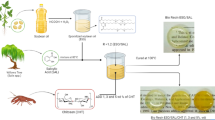Abstract
Epoxidized soybean oil (ESO) was thermally cured using methylhexahydrophthalic anhydride (MHHPA) curing agent in the presence of 2-ethyl-4-methylimidazole (EMI) catalyst. The curing characteristics of ESO/MHHPA/EMI systems were characterized using Fourier transform infrared spectroscopy (FTIR), a dynamic mechanical analyzer (DMA) and a differential scanning calorimeter (DSC). FTIR spectra showed that the polyesterification rate in ESO/MHHPA/EMI systems increased with increasing of the catalyst concentration. DSC thermograms indicated that EMI-catalyzed ESO/MHHPA systems experienced enthalpy relaxation at low EMI concentration whereas the extent decreased with increasing of the EMI concentration. There is a direct relationship between the degree of conversion and crosslink density of the thermal cured ESO/MHHPA/EMI systems with EMI concentration. The curing characteristics of thermal curable ESO thermosetting resins were found to have influence on the thermal properties of the ESO systems. It was determined that the glass transition temperature (T g) and storage modulus (E′) of cured ESO increased with increasing the EMI concentration whereas the damping properties of the ESO/MHHPA/EMI systems exhibited the reverse trend. It was found that the thermally curable ESO thermosetting resins experienced a two-stage thermal decomposition process.







Similar content being viewed by others
References
Wan Rosli WD, Kumar RN, Mek Zah S, Mohd Hilmi M (2003) UV radiation curing of epoxidized palm oil-cycloaliphatic diepoxide system induced by cationic photoinitiators for surface coatings. Eur Polym J 39:593–600
Jin FL, Park SJ (2008) Impact-strength improvement of epoxy resins reinforced with a biodegradable polymer. Mater Sci Eng A 478:402–405
Tan SG, Chow WS (2010) Thermal properties, fracture toughness and water absorption of epoxy-palm oil blends. Polymer Plast Tech Eng 49:900–907
Boquillon N, Fringant C (2000) Polymer networks derived from curing of epoxidized linseed oil: influence of different catalysts and anhydride hardeners. Polymer 41:8603–8613
Jin FL, Park SJ (2007) Thermal and rheological properties of vegetable oil- based epoxy resins cured with thermally latent initiator. J Ind Eng Chem 13:808–814
Takahashi T, Hirayama KI, Teramoto N, Shibata M (2008) Biocomposites composed of epoxidized soybean oil cured with terpene-based acid anhydride and cellulose fibers. J Appl Polym Sci 108:1596–1602
Gupta AP, Ahmad S, Dev A (2010) Development of novel bio-based soybean oil epoxy resins as a function of hardener stoichiometry. Polymer Plast Tech Eng 49:657–661
Ortiz RA, Lopez DP, Cisneros MLG, Valverde JCR, Crivello V (2005) A kinetic study of the accelerated effect of substituted benzyl alcohols on the cationic photopolymerization rate of epoxidized natural oils. Polymer 46:1535–1541
Jiratumnukul N, Intarat R (2006) UV radiation energy consumption in curing process of epoxidized sunflower oil-organoclay hybrid coatings. J Met Mater Min 16:53–56
Crivello V, Carlson D (1996) Photoinitiated cationic polymerization of naturally occurring epoxidized triglycerides. J Macrol Sci A 33:251–262
Sanchez-Cabezudo M, Prolongo G, Salom C, Masegosa M (2006) Cure kinetics of epoxy resin and thermoplastic polymer. J Therm Anal Calorim 86:699–705
Gerbase E, Petzhold L, Costa O (2002) Dynamic mechanical and thermal behavior of epoxy resins based on soybean oil. J Am Oil Chem Soc 79:797–802
Kolar F, Svitilova J (2007) Kinetics and mechanism of curing epoxy/anhydride systems. Acta Geodyn Geomater 4:85–92
Li Y, Gao J, Liu G, Zhang R (2001) Cure kinetics and thermal property of bisphenol-S epoxy resin and phthalic anhydride. Int J Polym Mater 49:441–455
Liu D, Shi Z, Matsunaga M, Yin J (2006) DSC investigation of the hindered effect on curing behavior for epoxy-phenol/mmt nanocomposites based on the acidic octadecylamine modifier. Polymer 47:2918–2927
Shin J, Nazarenko S, Hoyle E (2009) Effects of chemical modification of thiol-ene networks on enthalpy relaxation. Macromolecules 42:6549–6557
Shin J, Nazarenko S, Paige Phillips J, Hoyle E (2009) Physical and chemical modifications of thiol-ene networks to control activation energy of enthalpy relaxation. Polymer 50:6281–6286
Shokrolahi F, Sadi M, Shokrolahi P (2005) A study on curing kinetic of bisphenol-F using benzyl dimethyl amine by isothermal DSC. J Therm Anal Calorim 82:151–156
Tan SG, Chow WS (2010) Thermal properties of anhydride-cured bio-based epoxy blends. J Therm Anal Calorim 101:1051–1058
Asif A, Shi WF, Shen XF, Nie KM (2005) Physical and thermal properties of uv curable waterborne polyurethane dispersions incorporating hyperbranched aliphatic polyester of varying generation number. Polymer 46:11066–11078
Li GZ, Wang LC, Toghiani H, Daulton L, Koyama K, Pittman U (2001) Viscoelastic and mechanical properties of epoxy/multifunctional polyhedral oligomeric silsesquioxane nanocomposites and epoxy/ladderlike polyphenylsilsesquioxane blends. Macromolecules 34:8686–8693
Yang SJ, Lee C, Jang W, Kwon J, Sundar S, Han H (2004) Synthesis and characterization of poly(epoxy-imide) crosslinked networks. J Polym Sci Pol Phys 42:4293–4302
Kurdikar L, Peppas A (1995) The volume shrinkage, thermal and sorption behaviour of polydiacrylates. Polymer 36:2249–2255
Acknowledgments
The authors would like to express their appreciation to Universiti Sains Malaysia for the Incentive Grant (8021013) and the Research University Postgraduate Research Grant Scheme (USM-RU-PRGS 8043019). The authors also thank the Ministry of Science, Technology and Innovation (MOSTI), Malaysia for the National Science Foundation fellowship.
Author information
Authors and Affiliations
Corresponding author
About this article
Cite this article
Tan, S.G., Chow, W.S. Curing Characteristics and Thermal Properties of Epoxidized Soybean Oil Based Thermosetting Resin. J Am Oil Chem Soc 88, 915–923 (2011). https://doi.org/10.1007/s11746-010-1748-x
Received:
Revised:
Accepted:
Published:
Issue Date:
DOI: https://doi.org/10.1007/s11746-010-1748-x




